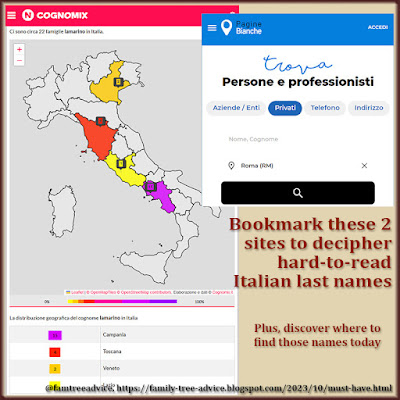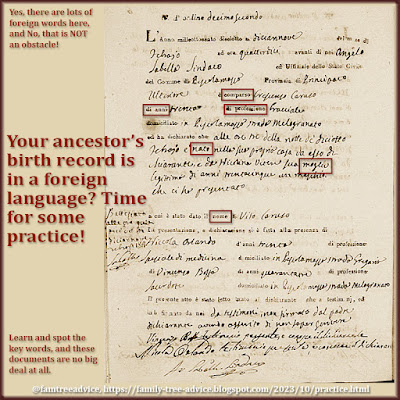Once in a while you'll find a document for your family tree with a new last name or place name you can't quite read. When that happens to me, I know exactly which free websites to go to.
Here are the 4 Italian genealogy bookmarks I use to solve a mysterious last name or place name. Two can help you decipher a last name and two can help you find a place on the map.
One quick note about using these websites. You'll usually see a pop-up ad before you can proceed. To dismiss the ad, click the button that says "Chiudi" (Close).
1. Map of Italian Last Names
Use the "Cognomix" website at https://www.cognomix.it/mappe-dei-cognomi-italiani to confirm the spelling of a last name. The site's main purpose is to show you all the places in Italy where you'll find any given last name.
That's very handy when you want to see if a last name is still found in a certain town. But another important use of the site is to check the spelling of a last name. I have one ancestor who came from a different town, but raised her family and died in one of my ancestral hometowns. Her last name was hard to decipher. I found it on more than one document, but that didn't help me. It looked a little different each time.
To figure out the right spelling, I went to the Cognomix site to try out different spellings. To use the site, scroll down a bit until you see a black bar that says "Mappe dei cognomi italiani." Beneath the bar is a blank box with the heading "Cognome," Italian for surname or last name. Type a name in the box and click the "Cerca" (Search) button.
First you'll see a map of Italy showing you how many families have that name and in which regions. Click any region to see how many families have that name in different provinces. Click any province to see the number of families with that name in different towns.
But—before you click the Cerca button, see if any suggested names pop up below the box where you're typing. If there are no suggestions, you're likely to find no results when you click Cerca. And you may find a better suggestion.
 |
| Can't read that Italian last name? Bookmark these free websites and solve the problem. |
I used Cognomix to figure out the ancestor whose name was new to me. The first writing of her name looked like Gajdia. (Note that sometimes in Italian words you'll see a j instead of an i.) When I type Gajdia in the Cognomix box, there are no suggestions. When I change it to Gaidia, there are still no suggestions. But one time, her name looked like Gasdia. When I type that into the box, Gasdia comes up as a suggestion. Now I can click Cerca to see where the name Gasdia comes from. I expect her to come from a town very close to where she lived after her marriage.
I discovered this uncommon name comes mostly from the Campania and Campobasso regions. That works for my family. By clicking a region and then a province, I can narrow down her likely place of birth. There's a good chance she came from either the city of Campobasso or the town of Fragneto Monforte.
My ancestor was born too early to find in vital records. If she'd been born later, I could try to track her records down in one of these two towns.
2. The Italian White Pages
The Pagine Bianche at https://www.paginebianche.it shows you exactly where to find a last name in Italy today. Look for a search area front and center on the website. Click the "Privati" button to search for a person by name (the default is to search for businesses). Then put the last name you want in the box that says "Nome, Cognome." In the second box, you can enter the town or province you want or make it blank (the default seems to be Roma).
If you get no results for a name, you may be spelling it wrong. When I put in Gasdia, I get 16 listings. One is in Campobasso and one is in Fragneto l'Abate, which borders Fragneto Monforte.
You can use the Italian White Pages to see if anyone with your last name still lives in your ancestral hometown. I find 3 people with my maiden name still living in my grandfather's hometown. I know exactly who they are. But there's another man with my maiden name in a neighboring town who I'd like to meet.
3. List of Italian Cities
The website at http://en.comuni-italiani.it/alfa is very important to my family tree research. Let's say I'm looking at marriage records from one of my ancestral hometowns. I see that the groom comes from another town, but I can't quite read the name of it. I think it starts with Mont and ends in an o.
The List of Italian Cities page divides all the country's towns into 98 groups (if I counted right). You do need to make an educated guess about the first letter of the town name. Then you can click the right group to get started.
I'll click the MONT–MONZ group to look for towns that begin with Mont and end in o. Once you click the group, scan the alphabetical list of town names to see if any seem like a possibility. You can click each possibility to see where it is on the map. That may help you rule out some towns because they're too far away.
 |
| Can't understand that Italian town name? Bookmark these free websites and find that place on the map. |
When you find a town that seems like the right one, compare its spelling to the original handwriting. Do you feel confident in your choice?
This website has come through for me time and time again.
4. The Parishes in Italy
If I have a baptism record for someone from another town, I like to add the address of the church to my family tree. But what if I can't quite read the church name?
That's when you need the list of Italian parishes at https://italia.indettaglio.it/eng/parrocchie/parrocchie.html. The main page of the website divides the country into regions. Click a region to find a search form with 3 categories:
- Province
- Town
- Village
Use the most specific of the 3 that you can. For instance, I'd like to find the parish name for a town in the Avellino province called Santa Paolina. I can choose Santa Paolina from the Town list and click the Search button.
The results page tells me that Santa Paolina Vergine is the parish for this town. It evens tells me how many people belong to the parish. And it gives me the address, Piazza Novembre IV, that I can use in my family tree for baptisms and marriages. If I enter that address in Bing Maps or Google Maps, I can see the church for myself!
You may want to create a folder of bookmarks just for Italian genealogy, as I've done. That way they're handy when you need them. As you work on your family tree, turn to these 4 tools to help you figure out a hard-to-read last name or place name.


